This is a complete guide to creating a high performing SEO content marketing strategy.
In this in-depth guide you’ll learn:
- The difference between an SEO content strategy and regular content marketing
- How to find your topic pillars (regardless of industry)
- How to tap into a never ending stream of hot content ideas
- How to conduct effective keyword research
- How to create content for links
- A step-by-step walkthrough of building an SEO content strategy
- How to move people through the customer buying journey
If you’ve been struggling to make traction with SEO, content marketing, blogging, or have hit a wall with performance… then this guide is for you.
Let’s dive in.
#1. What is an SEO content strategy and how is it different?
By now you should have:
✓ A thorough understanding of your audience
✓ Their problems, pains, challenges and desires
✓ Their current sources of relevant content (websites, YouTube channels, Podcasts, social media, publishers, industry organisations etc)
✓ Your business and marketing goals
✓ Your defined and well positioned brand
✓ Your content marketing mission
Armed with the above, you’re ready to put together an SEO content marketing strategy.
Reminder: A strategy is a means to achieve a goal. So an SEO content marketing strategy is how we will use SEO and content to achieve the goal(s).
You might need different content strategies for different goals, audiences and product/service categories.
Even different departments within your organisation may require different content strategies to achieve their objectives (if it’s a large company).
This post doesn’t cover social media content marketing or other content marketing channels (although some principles will apply).
The focus here is on creating an SEO content marketing strategy.
This means the goals will involve:
- Increasing visibility (rankings) in search
- Increasing or acquiring rankings for specific, high intent, commercially valuable keywords
- Driving traffic to your website from organic search
- Increasing awareness, engagement and trust with your target audience
- Grow your audience
To rank highly in the search results, you need the right technical SEO foundation combined with high quality content and links.
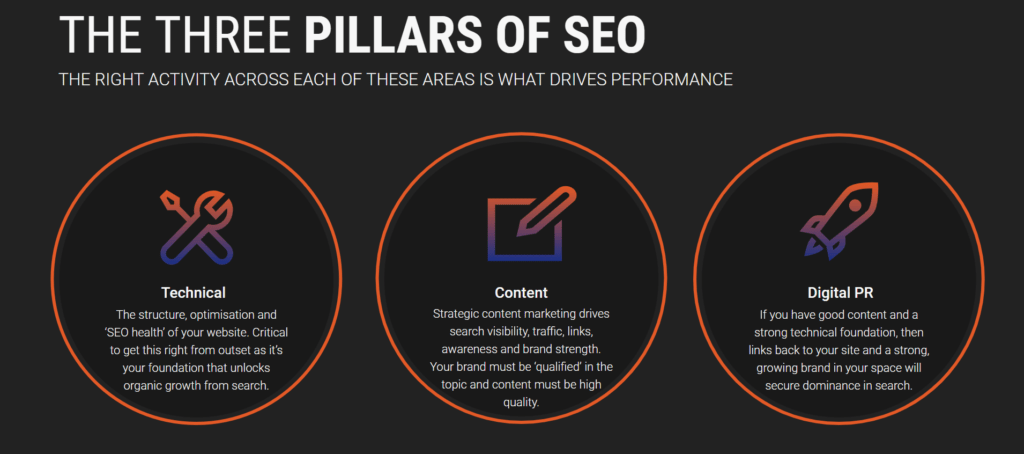
The holy grail of SEO is ranking for high intent keywords that people in-market search for when they are looking for your products and services.
Thing is, product and service pages don’t tend to attract high quality links. It’s not natural unless there’s something quirky about the page or if the product is super unique or desirable and happens to go viral.
Even if you do rank well for your top commercially valuable keywords, do you have a strong brand that has developed trust with the target market?
Are people searching for these high value keywords likely to have seen and engaged with your brand before? Or is this the first time they will become aware that your brand even exists?
If you reach and engage your target audience early, by the time they come to search for what you offer, they are already familiar with your brand and are:
- More likely to click on your listing in the search results over competitors
- More likely to convert and become a customer
What about after they become a customer?
Are they left to disengage and forget about you, or are you actively keeping your brand front and centre of their mind to increase retention, repeat purchases, upsells, cross-sells and lifetime value?
All these things can be achieved through an effective SEO content strategy.
—
Let’s back up, break it down and get stuck in.
We know you need content and links and that people don’t really link to product and service pages.
An SEO content strategy provides people with interesting, referenceable, educational, entertaining or impactful content to link to as a reference point or supporting material for their own content.
The content created and links generated, builds your expertise, authority and trust on the topic and in turn, helps you to rank for the in-market customer keywords that people search for when looking for your products and services.
But not only does it enable you to rank for the high value keywords, it reaches your audience earlier, generates a lot more awareness and traffic, builds trust through the value you are providing and positions your brand as an expert in the space who can help them.
#2. Identifying your topic pillars
SEO content strategy for brands in Tier 1 vs Tier 2 industries and why this matters when it comes to topic pillars
A tier 1 industry is if your audience is interested in topics that directly relate to your products and services.
Example tier 1 markets:
- Ourselves! A digital marketing agency offering digital marketing services to clients who are marketing professionals and interested in learning more about digital marketing
- A national chain of fitness centres – people who go to a gym are interested in fitness related topics
A tier 2 market is where the audience interests and what you offer do not perfectly align (most businesses), or even align at all in some cases.
Example tier 2 markets:
- A retailer of office supplies
- The audience only want limited content about desks, chairs and stationary to help them choose at the time they are entering the market
- These topics alone are not likely to achieve the goals of links, high rankings and lots of organic visibility and traffic
- An energy drink manufacturer (I bet you instantly thought of Red Bull – the reason is expertly crafted and executed content marketing using bridging topics)
- The audience has very limited attention for content about energy drinks. Their interests are not perfectly aligned with the product
- They DO have a lot of interest in adventure, high adrenaline activities etc
- A manufacturing company
- The only thing in common with your audience is that they might be a fit (at some point) for what you sell
- They are people though, with jobs to be done, desires, challenges, interests, emotions etc
The way to approach topic pillars for tier 2 markets is with bridging topics (AKA shoulder topics)
Bridging topics enable you to capture audience attention and achieve the goals of the SEO content marketing strategy, even when the interests of your target audience don’t align directly with your brand, products and services.
A bridging topic is a ‘bridge’ between your brand and the audience interests.
The better you know your audience, the better bridging topics you will come up with.
It’s important that the bridging topics retain a connection to your brand though, but more on this shortly.
The only thing to remember is that this content will appeal to your target market as well as others who aren’t your target market.
That’s fine as you’re still achieving the objectives.
Ask yourself:
“Who might be thinking about [situation or moment in their day / life your product or service can be inserted]”
When you’ve mapped the day in the life of the audience, it makes it easier to extract the most important jobs to be done that your product, service or content can help them with.
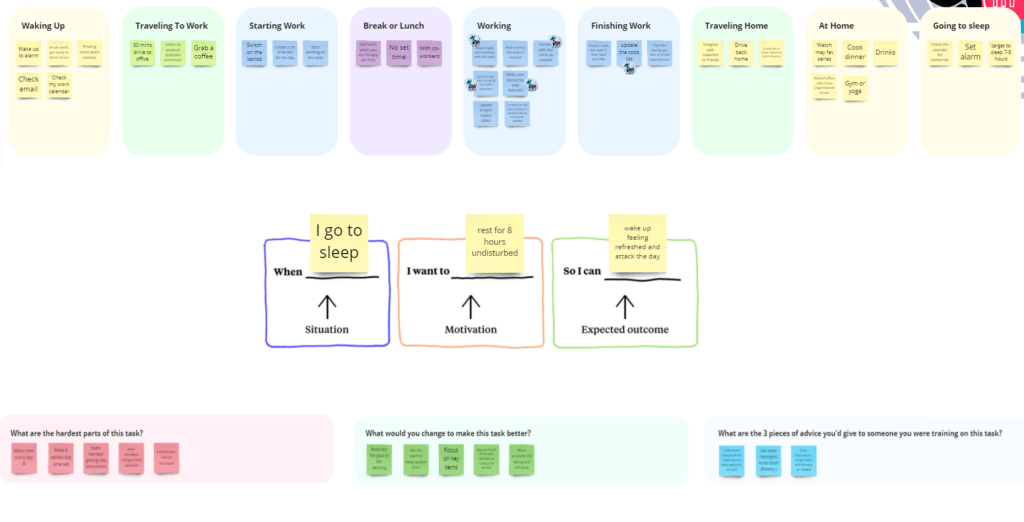
Let’s look at an example:
Let’s say you sell home office furniture. Who might be thinking about their home office or spending time in that environment?
Let’s say from research, a sizeable customer segment of your audience is single dads working from home.
Think about a day in the life of this person. Think about the ‘jobs to be done’ that he is trying to accomplish.
Jobs to be done could be:
- Finding time to stay in shape
- Time management techniques while battling constant distractions within the home
- Mental wellness and dealing with social isolation due to working from home
- Raising a child as a single parent
What are common occupations? What jobs to be done might they have in relation to their work?
Do they use spreadsheets for example?
People have built entire brands and 7-8 figure businesses from helping people use spreadsheets (Miss Excel – Kat) so there’s definitely interest there.
A bridging topic pillar and content series could be:
Microsoft Excel Bootcamp – a content series designed to help [audience X] achieve [desired end result].
—
What about his hobbies and interests?
What does his life look like during the working week vs at weekend?
What does he do in his spare time?
What does he struggle with?
What are his aspirations and desires?
A bridging topic pillar could be:
Helping Weekend Warriors escape the home office and live life to the fullest.
—
You should know your audience inside out from your audience research. If you don’t, then go back to that section now and go through the steps to gain a better understanding of your audience.
We love this quote from Gary Vaynerchuk’s book (Ask Gary Vee) as another example of the effective use of bridging topics:
List every possible way your business, brand or product touches people, from what they eat, to their hobbies, to their conversation topics. Don’t box yourself in. Use your imagination and map out all the options.
For example a hardware store. If all you see are tools, paint and adhesives you are sadly mistaken.
People see their dream home, their kid’s fort, a finished ‘honey please do’ list, a new vegetable garden or bird feeder. They see their problems solved, their rainy days filled or their closet space doubled. They see Habitat for Humanity or Eagle Scouts or Pencils of Promise. They might see sweat and exercise or inspiration, change, craft and fun.
How many relevant bridging topics could you create just from that one paragraph?!
Topic research to identify your pillars is coming up in a minute, but first we need to mention brand connection.
Coming up with bridging topic ideas is one thing, but you need to connect them to your brand.
There’s a couple ways to do this and it depends on how closely connected the bridging topics are.
In the hardware store example above, the connection is that the products can be used to help the audience fulfil their interests, desires and jobs to be done.
The other way is to think about your purpose – why your brand exists – and any key brand themes, values or messages.
What does your brand stand for or want to be known for?
Mesh these things with the topic, so you talk about the topic in the context of the brand purpose, values, themes and what it wants to be known for.
Example:
Brand theme/value: Innovation
Audience interest: Technology
Instead of just talking about technology in the general sense like everyone else, you would create content about technology with the angle of innovation.
A final way (for the purposes of this guide) to stay connected to the brand is create a mind map.
Mind Mapping the connections from the main brand, purpose, products and services, will visually highlight how far away from the brand a particular topic might be and ensure you stay more closely connected to the brand with your topic pillars.
Here’s an example mindmap using ourselves.
When you create these mindmaps, start off by letting your creative mind run free. Try not to think and just map connections as they come to you.
Remember that the goal of doing this exercise is to help you come up with ideas for content pillars and topics. Any ideas that jump out at you while doing this, are things you might want to consider for your content strategy and research further.
*Click the image to make it bigger if it’s hard to read
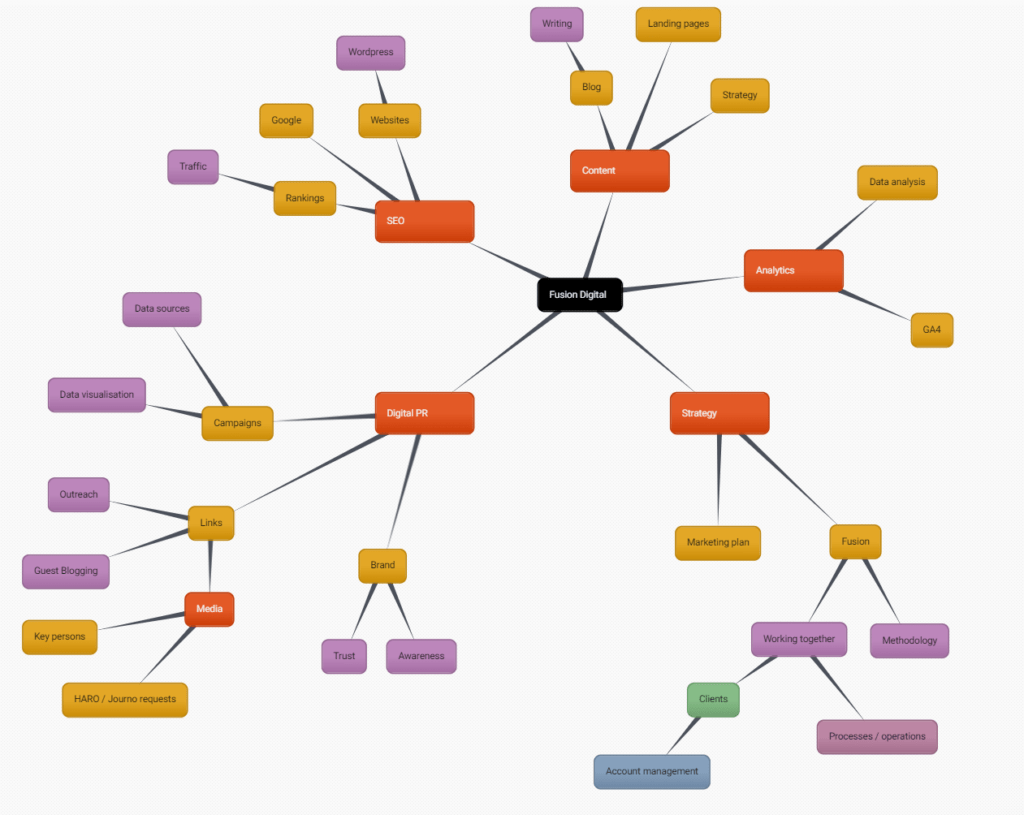
Here’s an example content mindmap of a hardware store:
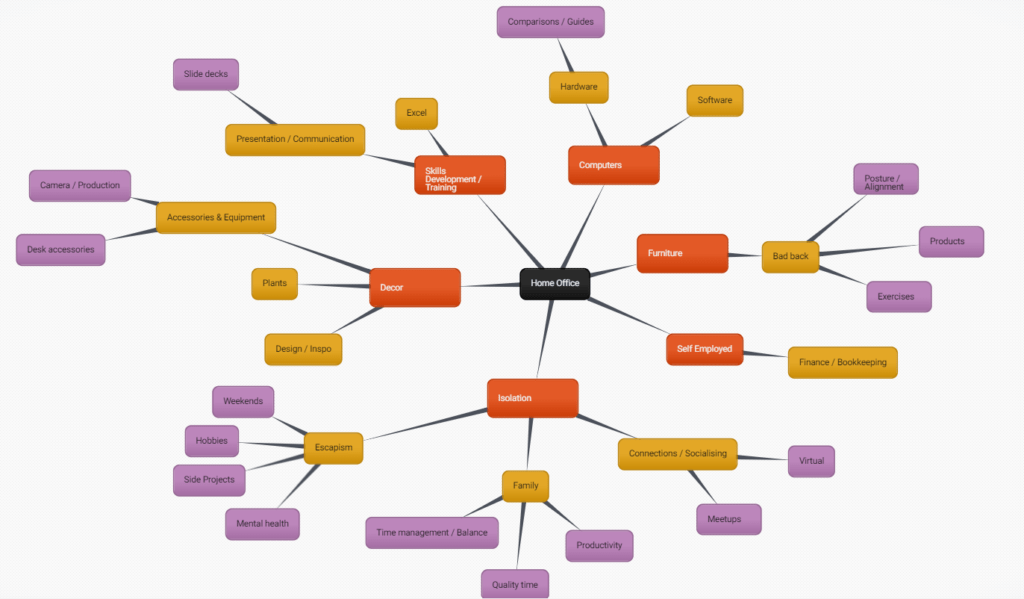
If your brand lacks credibility or expertise in the topic and nobody in the company can be the face of the topic, then source and align your brand with expert content creators who do have experience and credibility in the topic.
In summary:
Talk to the interests of the target market but in a way that relates to the brand and/or products and services.
10 ways to identify the core topic pillars that will be central to your SEO content strategy.
A quick clarification on naming convention:
- A topic pillar is a main category.
- Within each topic pillar will likely be a list of subtopics (sometimes referred to as clusters).
- Topics are the individual content pieces.
Let’s dive in.
—
Topic Pillars Method 1: Sparktoro
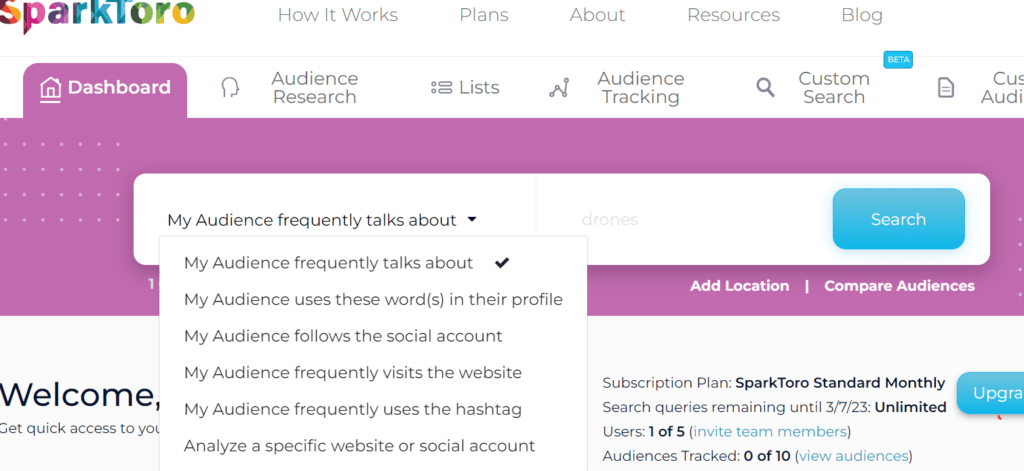
To get a feel for audience interests to inform your topic pillars, Sparktoro is a great place to start.
With the audience search bar, you might need to play around with different angles to get close to your target audience.
Some ways you might want to search are:
- Their job title
- Their interests
- Social / industry organisation accounts they are likely to follow or websites they are likely to visit
- Their jobs to be done
- Any potential topic pillars you already brainstormed – e.g the Weekend Warrior or Microsoft Excel examples we used in the previous section
Once happy you have a representation of your audience, you should then look at the below sections:
- Hashtags used
- Phrases used
- Social accounts they follow
- Websites they visit
- Podcasts they subscribe to
- Reddit threads they engage with
- YouTube channels they watch
- Relevant press they engage with
With hashtags and phrases used, look for potential topic pillars where it makes sense for your brand to enter the conversation and capture their attention.
For all the rest, visit the account or website and look at the common topics they create content around. Note down topic pillar ideas.
For websites specifically, look at the content categories, especially niche industry publications.
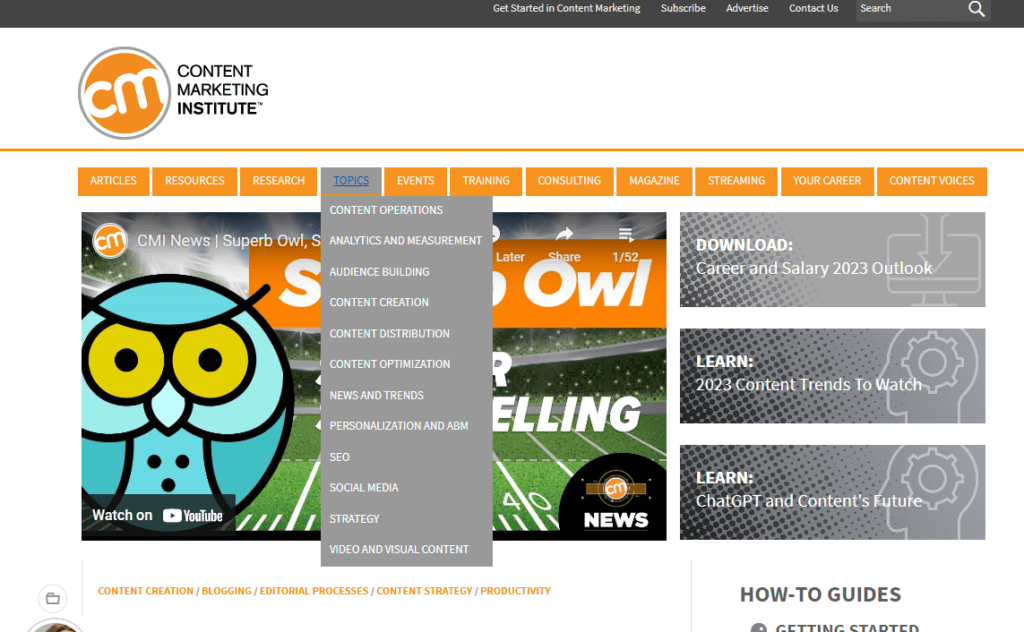
Topic Pillars Method 2: Udemy
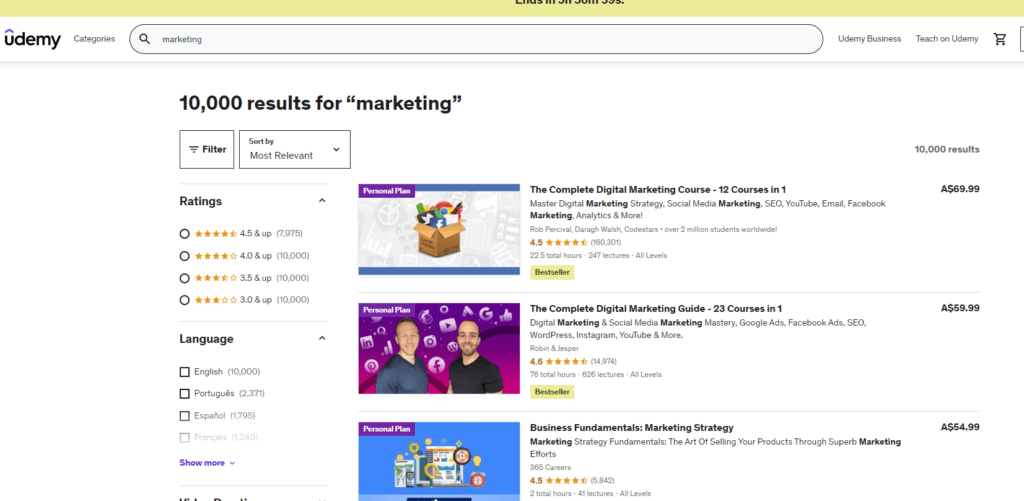
This is content people are PAYING for. If they are paying for it, then these topics have high perceived value and they want to learn more about them.
Look for courses on relevant topics. The main topics of the courses might be sufficient to inform your own topic pillars, but you should also go into the course and look at the modules.
A goldmine of topic and subtopic pillars!
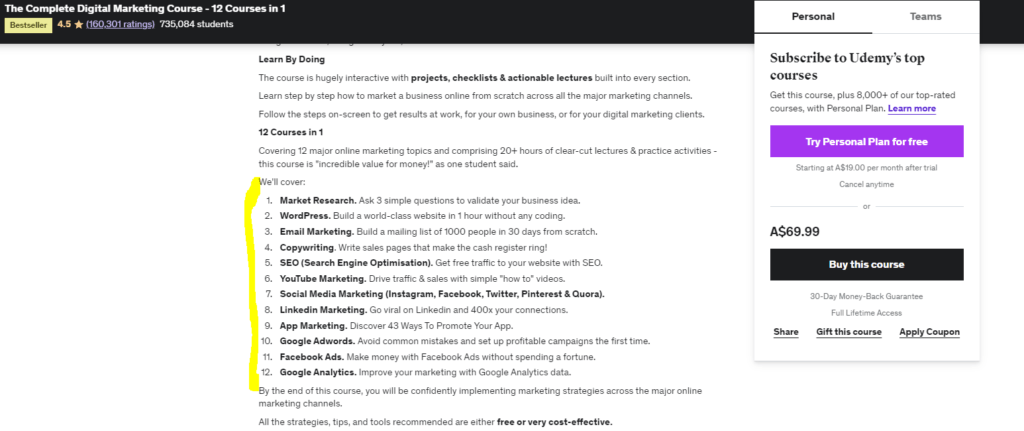
Topic Pillars Method 3: Books
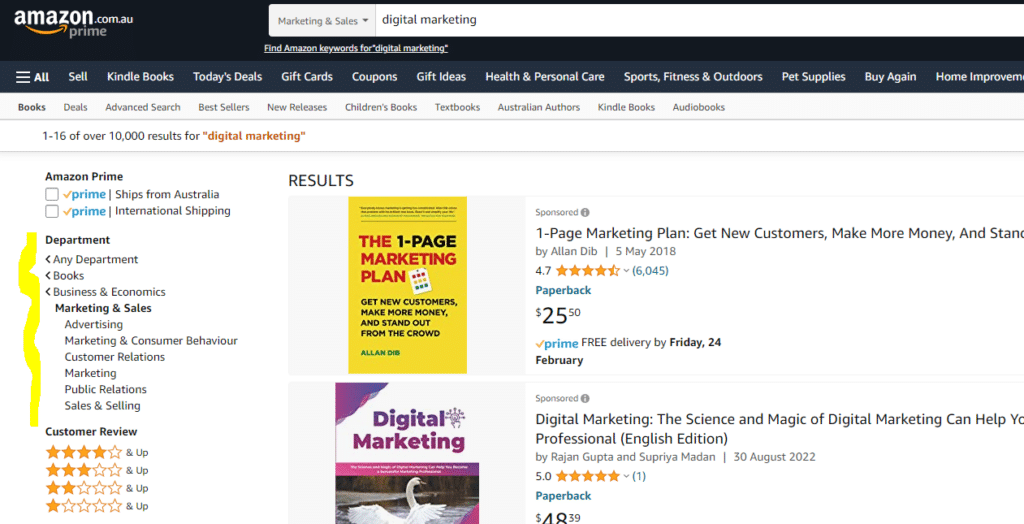
Similar to Udemy, there’s books on almost every topic and interest imaginable.
Head over to Amazon and the books category. Before you dive into the books themselves, drill into the categories to the left as you will likely get some good topic pillar ideas here too.
Browse through the books and note ideas for topic pillars.
Pro Tip: Visit the book product pages and some of them have a ‘Look Inside’ option. Click this and look at the category page for more topic and subtopic pillar and topic ideas.
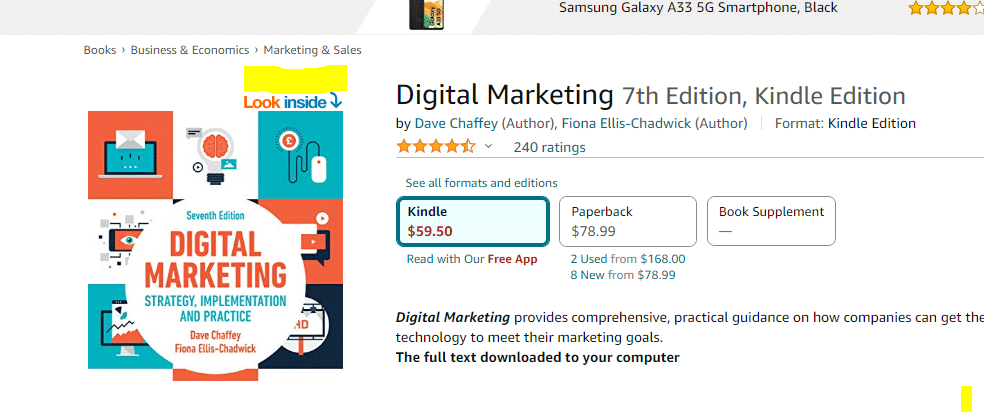
Topic Pillars Method 4: Your deepest expertise
What is the one problem you or people on your team can help an audience solve better than everyone else / most others?
Is there a unique or rare angle or perspective you or your team can offer to a particular problem, desired end result or job to be done of your target audience?
Let’s say you’re a children’s day care brand. Typical topic pillars might be around kids’ activities, kids’ learning tips etc.
Digging deeper, you might learn that you have a team with an extraordinary level of experience between them in working with children and over that time, they have become exceptionally adept at handling behaviour issues.
This could make an excellent topic pillar with an angle that your brand is well positioned to answer.
Topic Pillars Method 5: Their jobs to be done
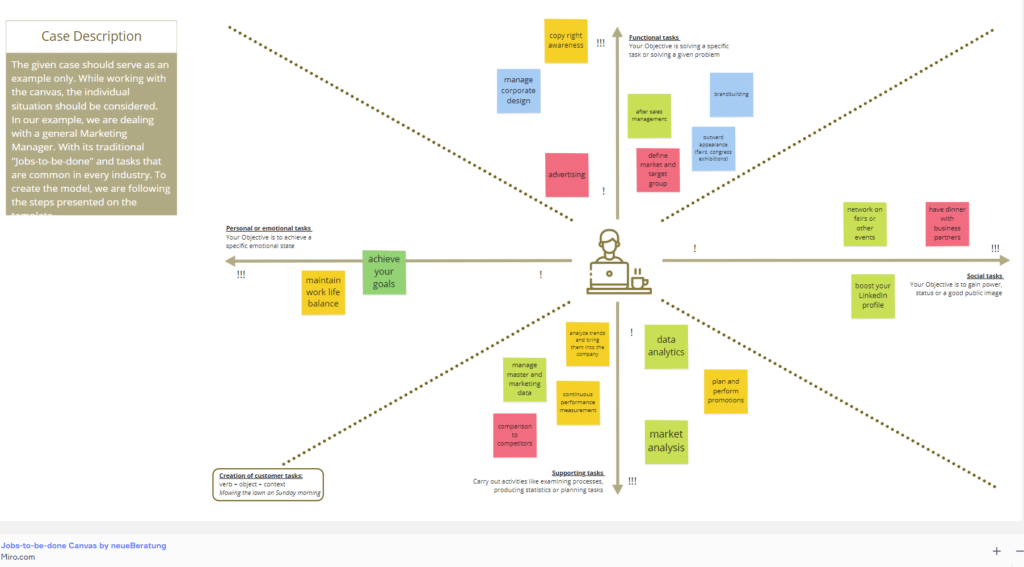
Source: https://miro.com/miroverse/
Your audience will likely have one or more jobs they are trying to complete in a particular situation in their life (that your products and services can help them with). This is especially true for B2B audiences.
‘Jobs’ aren’t just functional though. There’s an emotional level of jobs, then another dimension of personal reasons vs social status reasons.
Identify the main jobs to be done and create topic pillars based on these, with content aimed at helping them to complete the job or do it better, faster, cheaper etc.
Given you offer solutions to support this, you should be well positioned to talk about the topic in detail.
Notice we said talk about the topic in detail, not talk endlessly about your products and services. There’s a time and place for that and it’s usually about 10-15% of your overall SEO content strategy.
Here’s another template canvas example available on Miro:
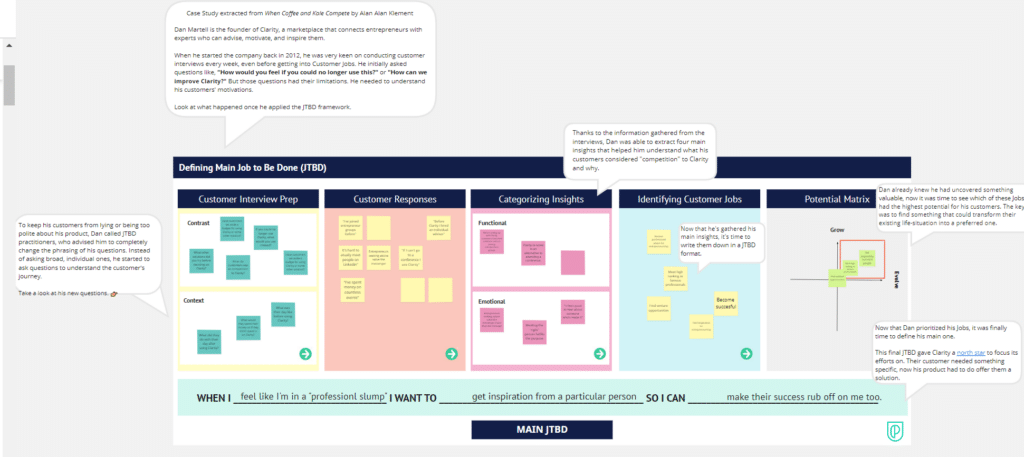
Source: https://miro.com/miroverse/jobs-to-be-done-jtbd-for-product-managers
Topic Pillars Method 6: Your customers, sales and customer service teams
What you’re looking for if you are mining these audiences for topic pillars and topic inspiration is the burning problems and recurring themes.
What topics come up time and time again, perhaps communicated in different ways?
Note down these to inform your topic and subtopic pillars as well as individual content topics.
Pro Tip: Ask them to check their sent emails and chat history. Sales and customer service usually answer prospect and customer queries all the time, so this can be a goldmine of content ideas, with recurring themes having the potential to be a pillar.
Creating content around these topics also makes their lives easier as they can refer future queries to the content.
Topic Pillars Method 7: Google Image Search

Head over to Google Image Search and start entering broad topic areas.
Look at the suggestions below the search box. Often there’s good inspiration for topic and subtopic pillars. Keep digging to find more.
Pro Tip: This tactic can work for any site that shows related categories/topics to your search.
Topic Pillars Method 8: Quora

Head to Quora.com and browse the spaces. You’ll no doubt find good inspiration for topic and subtopic pillars and topic ideas for your SEO content marketing strategy.
Topic Pillars Method 9: Reddit
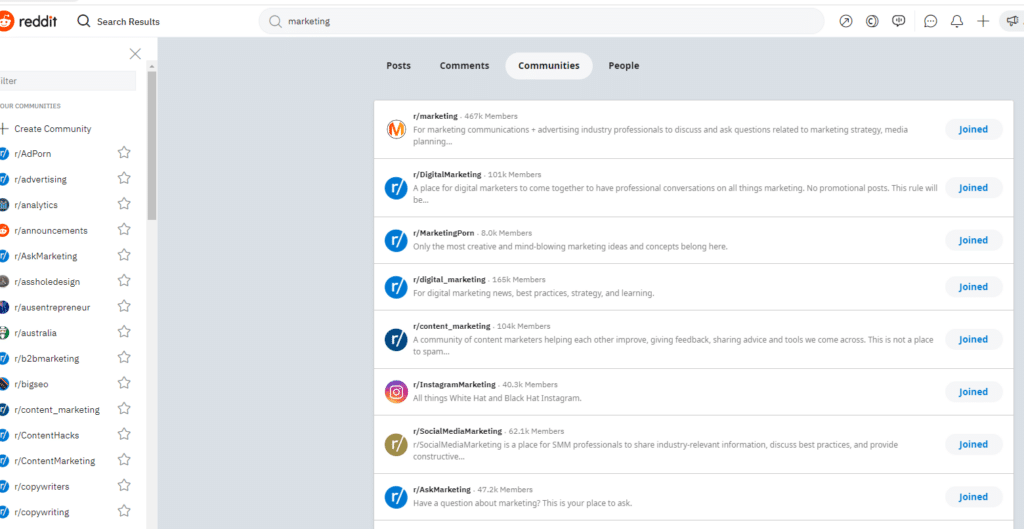
Similar to the Quora method, we’re using Reddit this time. Search for a broad topic and look under the communities tab.
There’s Reddit communities on just about every topic imaginable so scroll through this list and note any ideas that you see for your own topic and subtopic pillars.
Topic Pillars Method 10: Keyword & Topic Search Tools
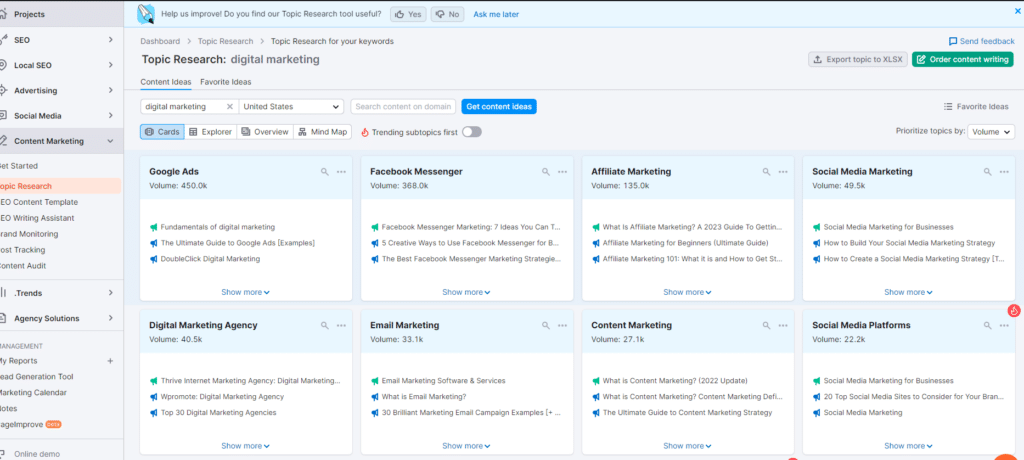
There’s several tools you can use for this. SEMRush, Google Ads Keyword Tool, Buzzsumo, Answer The Public, Ubersuggest, Ahrefs, Contentideas.io etc.
The premise is the same in that you will start searching for broad, top level keywords/topics, then look for and drill into groups that could make for good topic and subtopic pillars.
Here’s contentideas.io:
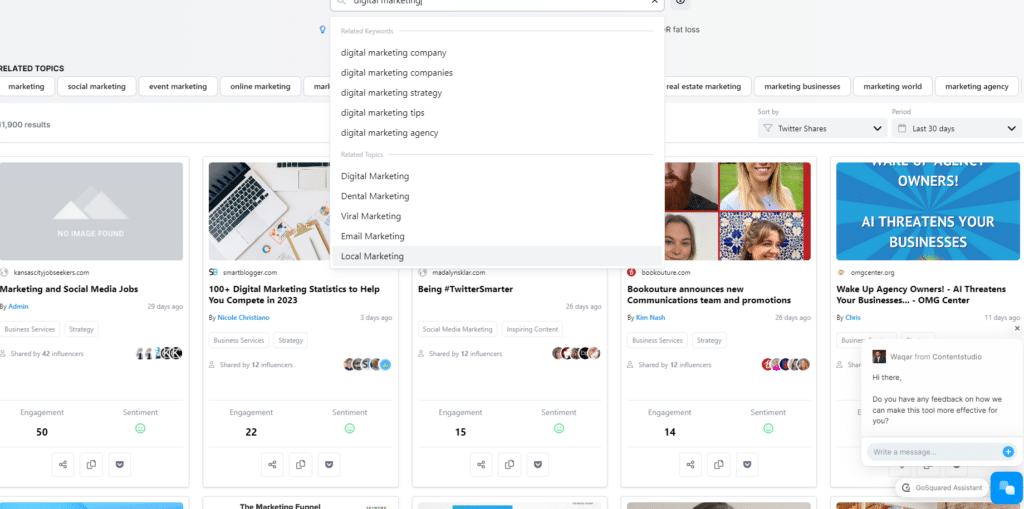
Topic Pillars Bonus Method: ChatGPT
We couldn’t not include this of course! The AI revolution is upon us.
Basically just ask it… with the right prompts.
Also don’t just take whatever it says and run with it. Use it to help you focus and accelerate the research in the previous 10 steps.
1. Give it a role
You are a senior SEO and content marketing strategist who works for https://fusiondigital.agency You should review the website link to learn more about the brand, products, services, positioning, USPs and tone of voice in addition to the context provided.
2. Give it a task
You need to create a full funnel content marketing strategy to attract, engage and convert their target audience. We will start with identifying the best 5 content topic pillars for this strategy and the 5 topic sub-categories within each pillar that align audience interests with the brand core and what it makes sense for the brand to talk about.
3. Give it context
Upload brand guidelines, give it more links to review, give it details about the target audience, products, services, brand and as much supporting information as possible.
4. [optional] Give it examples and tell it what you like and don’t like and what to lean into or avoid.
Sometimes this helps and sometimes it hinders in our experience.
#3. How to find smoking hot content ideas that attract your audience like moths to a flame
By this time, you should have topic and subtopics identified and therefore be starting to create the foundations of your content marketing strategy.
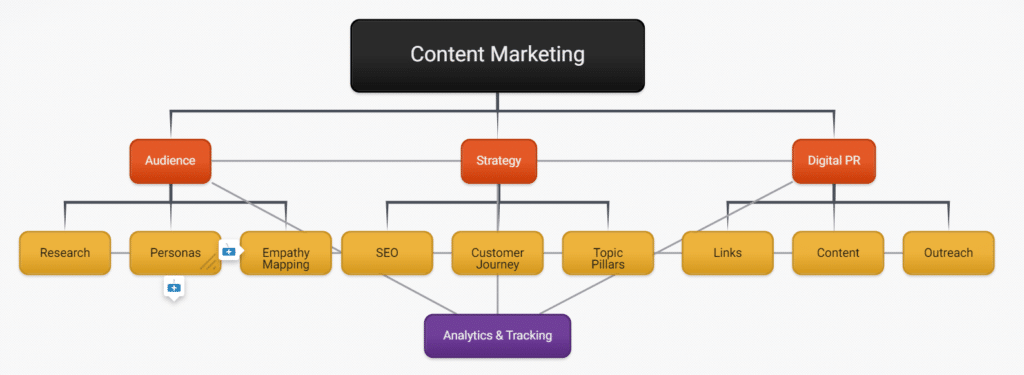
Before you head off to find topics to write about, get clear on the main types of content and their purpose.
Knowing this will help you when designing your SEO content strategy plan:
- Search / Evergreen
- Content that aligns with what people are actively searching for
- Link Acquisition / Distribution
- Content that is designed to attract links
- Trend
- Content that joins the conversation around – ideally at the start of – a trending topic
Search focused content will form the majority of your SEO content strategy, followed by content designed to attract links. Content for trends we’ll just briefly cover so you understand the difference.
Get in front of a trending topic and ride the wave
Trending topics are often just that… a trend.
There will be a spike – which granted, could be a huge one – but then the trend search volume dies down and either it reduces to practically nothing, or it reduces to a consistent but much lower level.
To identify early trends just as they are starting to take off, use tools such as Exploding Topics, Spike by Newswhip, Google Trends or one of the many other tools available.
Join the conversation, create content, secure rankings and ride the wave of traffic as search volume rises.
Pro Tip: Remember the business goals and think of a way to funnel the traffic further in the buying journey, perhaps by offering a lead magnet download that they have to opt in to receive.
Search focused content strategy and topic planning
There’s a few different ways to approach this part of the strategy planning process.
- Choose a topic or subtopic pillar you want to increase in search visibility, your expertise and authority on the topic
- Or choose a specific product, service or category you want to increase the search visibility for, followed by the most relevant and closely related topic pillar associated with this
- In the ‘putting it all together’ section, you’ll learn how this works to improve the rankings of your products, services, categories and their target high value keywords
Then you can either start with topics or start with keyword research… often jumping between the two… but ensuring that nearly all content you create, is angled and optimised towards what people are searching for.
Keyword tools:
- SEMRush
- Ahrefs
- Keywordtool.io
- AlsoAsked
- Ubersuggest
- Answer The Public
- Google Keyword Planner Tool
- Keywords Everywhere
- Buzzsumo
- … plenty others to choose from!
Where to find topics:
- Forums
- Social groups
- Reddit communities
- Quora
- Blogs
- YouTube channels
- Podcasts
- Conferences
- Feedly – create listening posts
- Tools: Buzzsumo, Contentideas.io, SEMRush, ChatGPT/AI tools, Keywords Everywhere
In the above list with the exception of ‘Tools’, the process is a bit time consuming, but very simple and extremely effective.
You ready?
—
#1. Visit the forums and look for the hot threads (the ones with lots of activity/posts).
Go in these threads and look for the specific posts that are generating a lot of attention as this is a good sign it’s a hot topic.
Look at what people are saying. What’s the topic of discussion? What do people want to know? What’s causing debate?
In this example from bodybuilding.com, we can see that supplements is a smoking hot topic area (which would probably make for a good topic pillar if you are in this space).

Looking in the supplements category, we can start to see the hot topics that are capturing people’s attention and engagement.
The next step would be to go in the hot threads and see what people are talking about.
As you do this, note down recurring themes, questions and ideas that would be good to create content around.
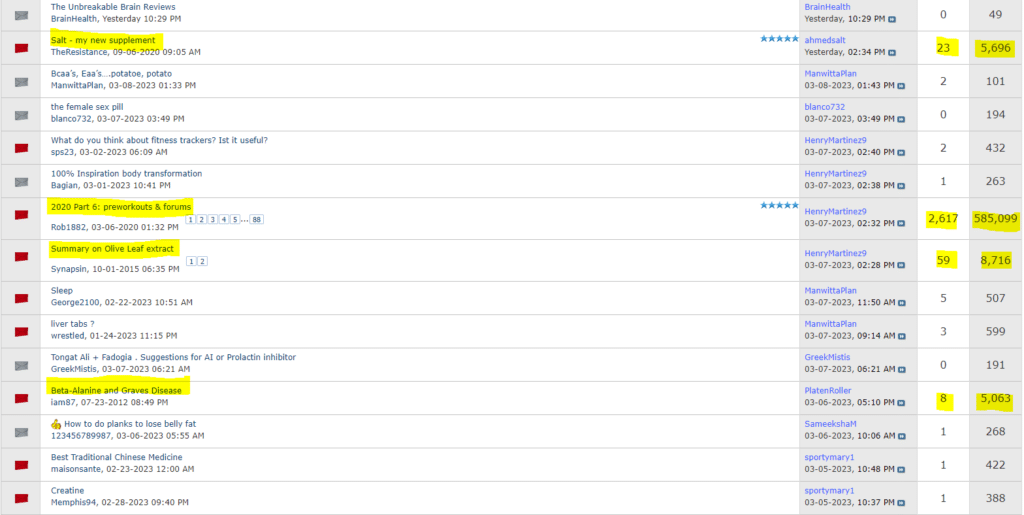
#2. Same thing with Reddit communities and Quora.
Go into the community thread and look at the hot posts that have lots of votes and comments. These are the hot topics.
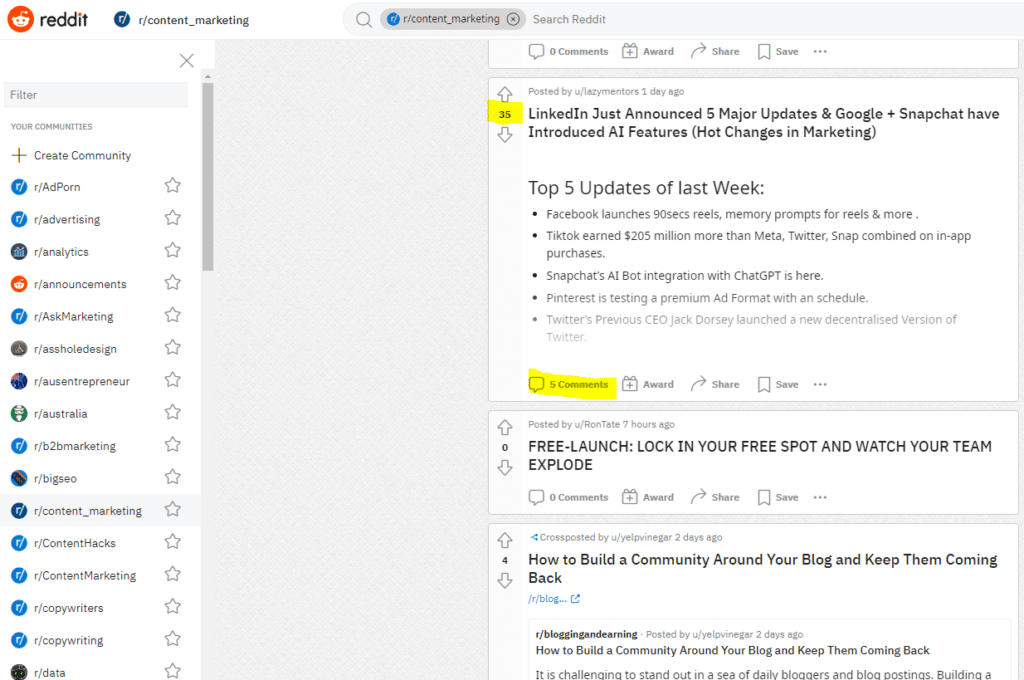
#3. Join relevant groups on social media and look for the posts that generate a lot of comments and engagement.
These are often good ideas for hot topics to create content around.

#4. Visit relevant blogs and look at the posts with lots of comments.
What are the comments saying?
What’s the sentiment and emotion? What’s the debate? What do people want to know?
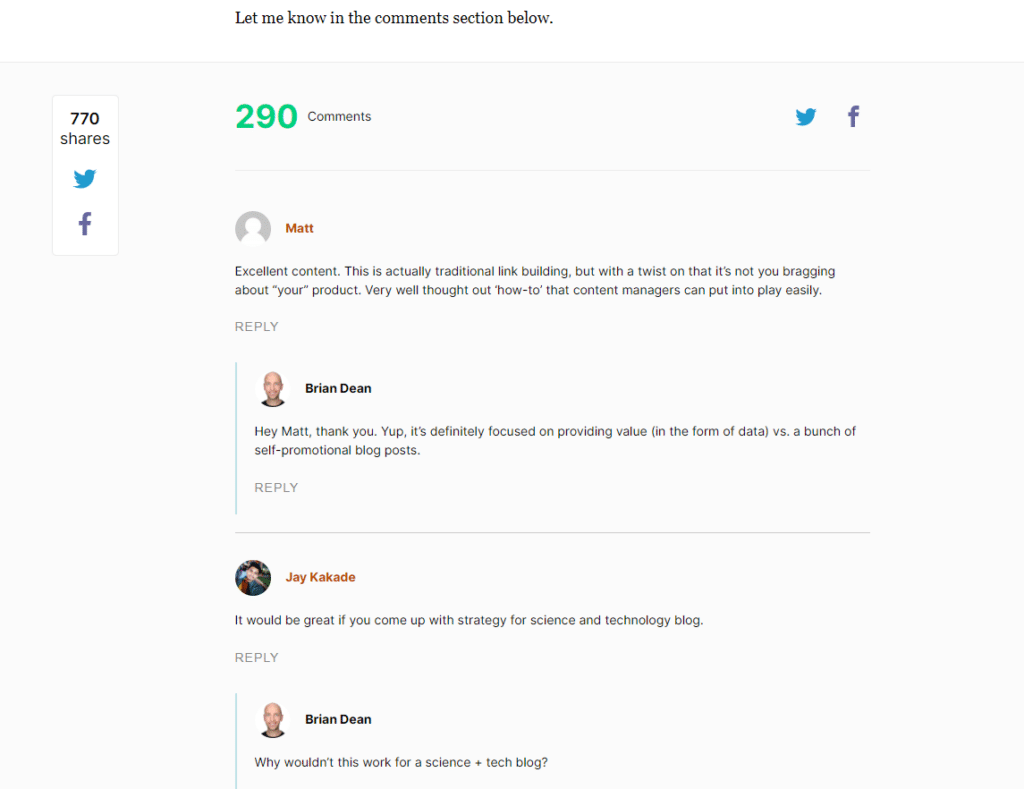
#5. Use tools like Buzzsumo, Contentideas.io and SEMrush
Use this as inspiration for your own content topics.
Where can you add value?
How can you cover the topic differently and in line with your own brand and audience?
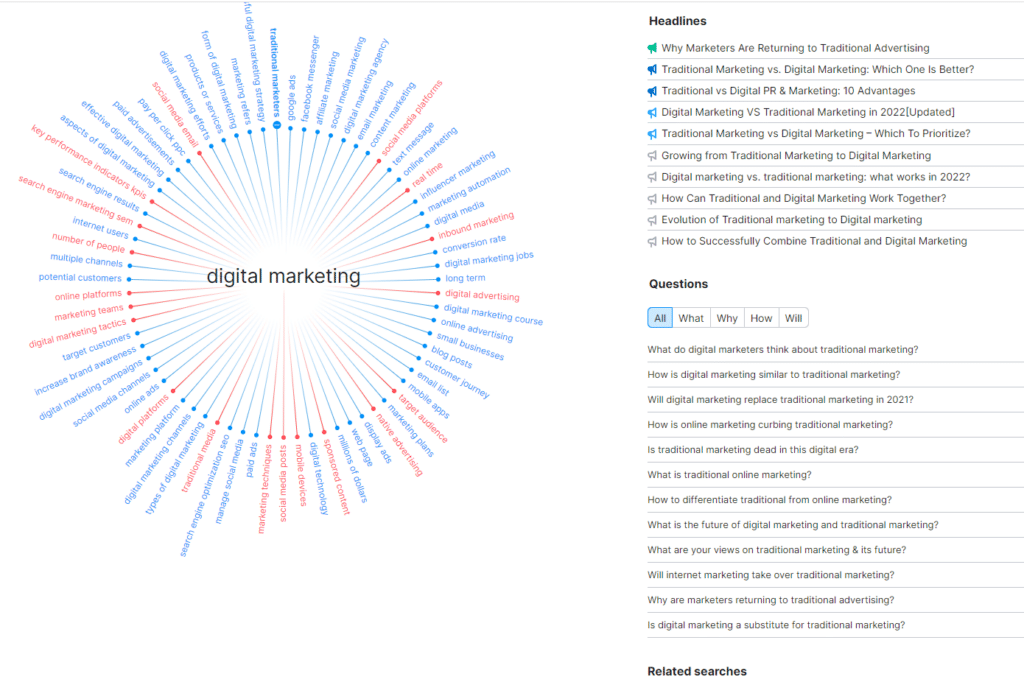
SEMrush topic research tool
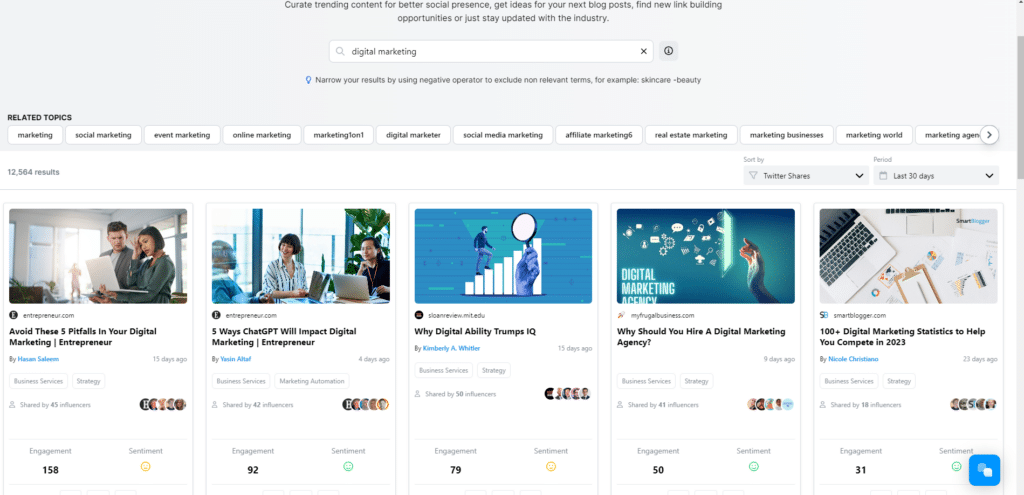
ContentIdeas.io topic research tool
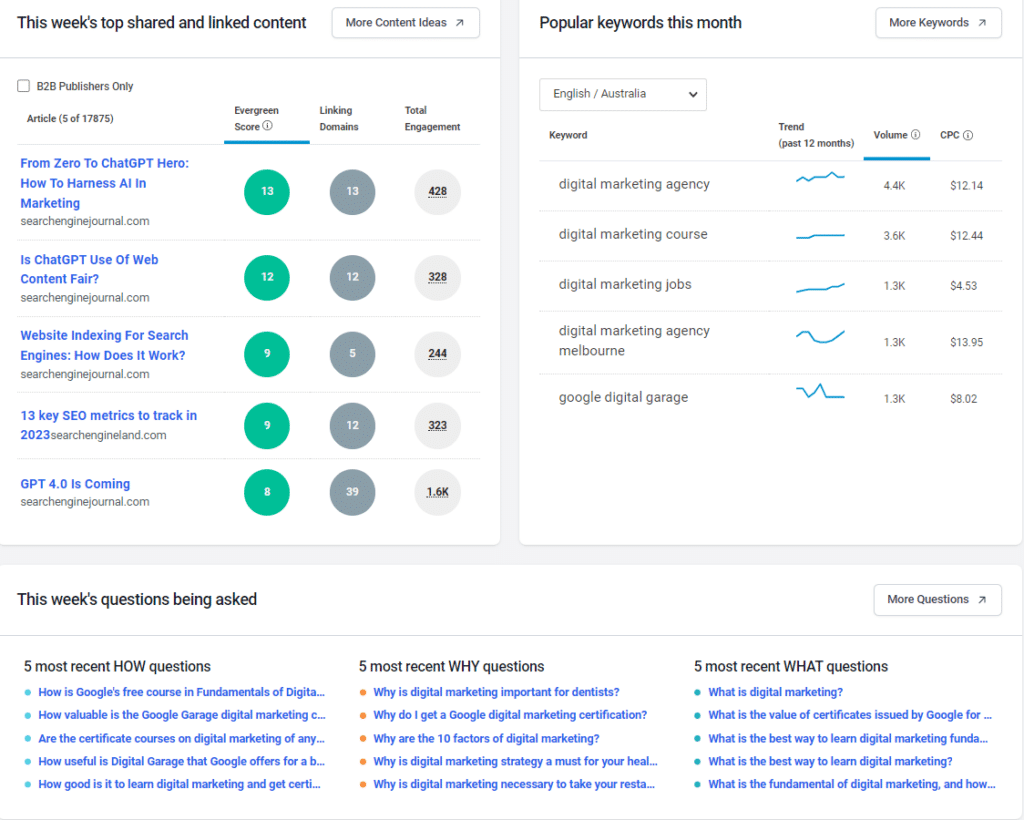
Buzzsumo topic research tool
#6. Browse through relevant YouTube channels and look for the videos with view counts that stand out from the norm for that channel.
Great topic ideas!
Also read the comments to get a feel for audience sentiment and what might be missing from the content that you can address and improve.
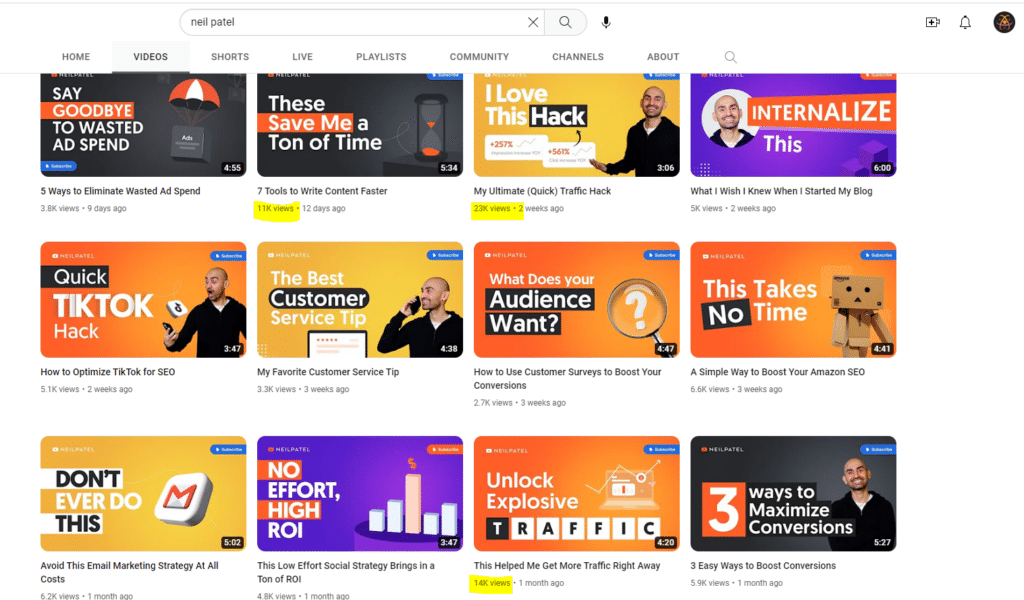
#7. Podcasts your audience listen to and conferences they attend
You can use Sparktoro to find podcasts.
Visit relevant shows and look at the topics they are discussing. Use these as inspiration for your own content.
Find relevant industry conferences that your audience might be interested in or attend.
Look at the speakers and the topics they will be presenting.
People often pay to attend these conferences and hear what the speakers have to say, so there’s usually great topic inspiration and ideas here for your own content.

Pro Tip: Set up Feedly.com as a listening post and be a fly on the wall in the world of your audience
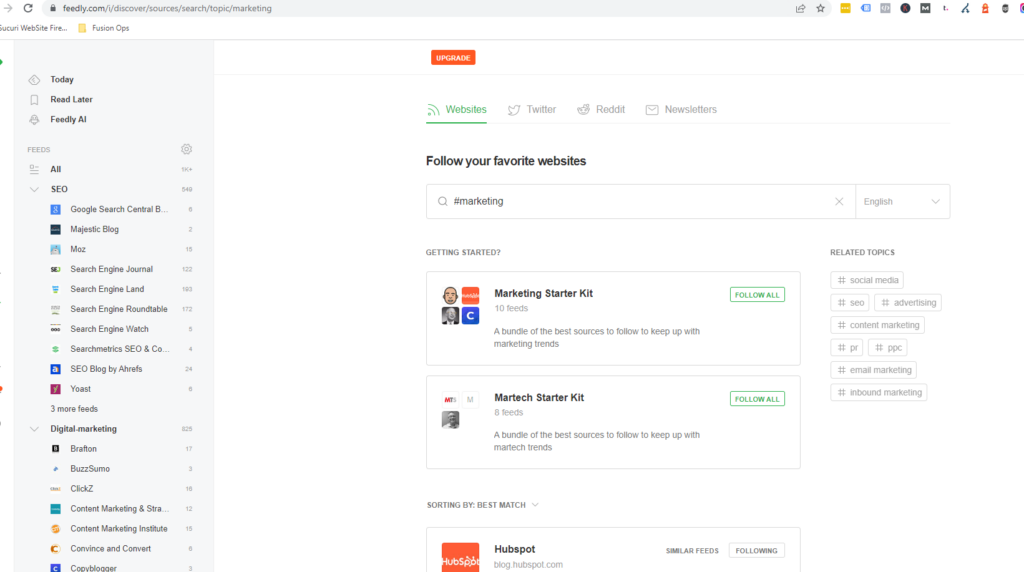
Build out the sources under your previously identified topic pillars.
A source is a website or blog that creates content around this topic pillar. You can add sources manually and/or find them through the Feedly search interface.
You now have a place to keep your finger on the pulse of what everyone is talking about at any given time. A priceless source of hot content topic ideas!
Next, scroll through the content and look for hot topics as inspiration.

Note: Don’t disregard a topic idea just because it has a low number of engagements. It might be a great topic, but that site might have a smaller audience and visibility compared to the bigger sites that generate high engagement numbers. Use your own judgement.
#4. Keyword research for content topics
If you started your SEO content planning with topic research and have a list of great topic ideas, you still need to carry out keyword research for each of those ideas to check that people are searching for it.
You might occasionally still want to run with a topic even if there isn’t any indication of search, but generally speaking, we’re creating a search focused SEO content strategy.
The goal being to increase search visibility and drive traffic from search engines… and for traffic to exist, there needs to be people searching for the topic.
For this you need tools.
If you started with topics then plug the broad topic into the keyword tool and look at the results.
Let’s take one of the talks from the earlier conference example:

For this, I entered into the keyword tool: Influencer marketing future
Usually looking under the questions tab is where you’ll find the long tail keywords that would be good to optimise the article around.
As you can see, there’s several good keywords here with a bit of search volume, several variations of the same search and low keyword difficulty, meaning there’s a high chance your content will rank on the first page easily.
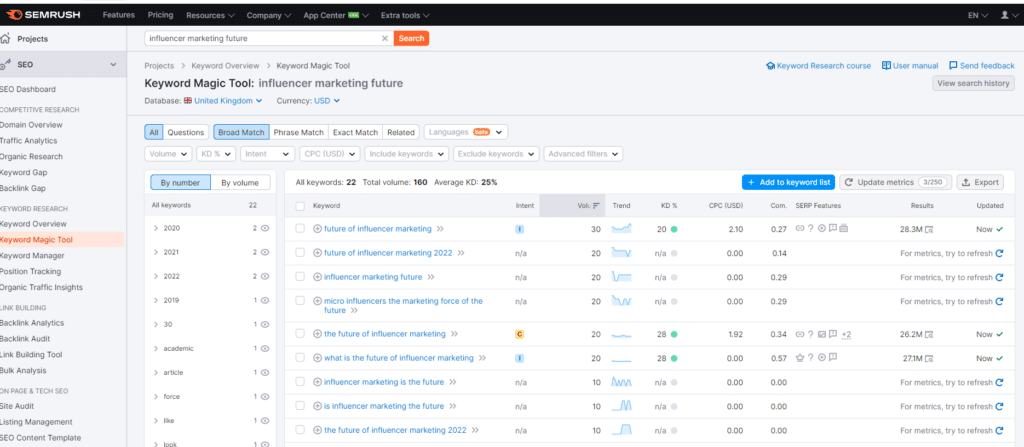
So the takeaway is instead of the content angle of “where will influencer marketing go next?”
You optimise it around “The future of influencer marketing” to align with the way people are searching so that your content gets in front of people and you generate traffic to your website.
Keyword focused topic research: The Fusion of your ability to compete, search volume and commercial value
The main criteria is:
- People search for the keyword
- Ideally people search for the same thing in lots of different ways (ie lots of different long tail keywords that are all looking for the same content)
- The competition – keyword difficulty and domain authority of the competing sites
- You have a good chance of ranking for that keyword or group of keywords based on the resource you are prepared to invest and the time it could take to rank
Other factors to consider:
- The traffic value of the keyword and are advertisers bidding on it (potential commercial value)
- The ‘low hanging fruit’ of content topics that you should consider targeting first due to the balance between your ability to rank, the traffic potential and the commercial value
Understanding domain authority and keyword difficulty to assess the competition and your ability to rank.
Domain authority (DA) is a measure of your site’s authority or strength if you like.

The higher the domain authority, the harder it will be for you to beat and outrank that site for that keyword.
On the flip side, if your DA is 50 and all the ranking sites for a keyword are 20, you should have a great chance to beat them and rank with far less effort.
There are a few variables to this and it’s not a hard and fast rule.
If your brand is well known on the topic and you have a lot of experience and credibility on this topic compared to other sites, then that can work in your favour too.
This can be shown through good author bios, awards, membership of trusted industry associations, strong digital PR generating lots of third party validation and credibility etc… but this is a deep topic for another post!
There’s also a metric called Page Authority and this is the same sort of measure, but for the individual page. This is much less important than Domain Authority but worth mentioning.
Keyword difficulty is a measure of how competitive and challenging it is to rank for that keyword.
If you use Ahrefs, also look at the estimated number of referring domains you might need to rank for this keyword.
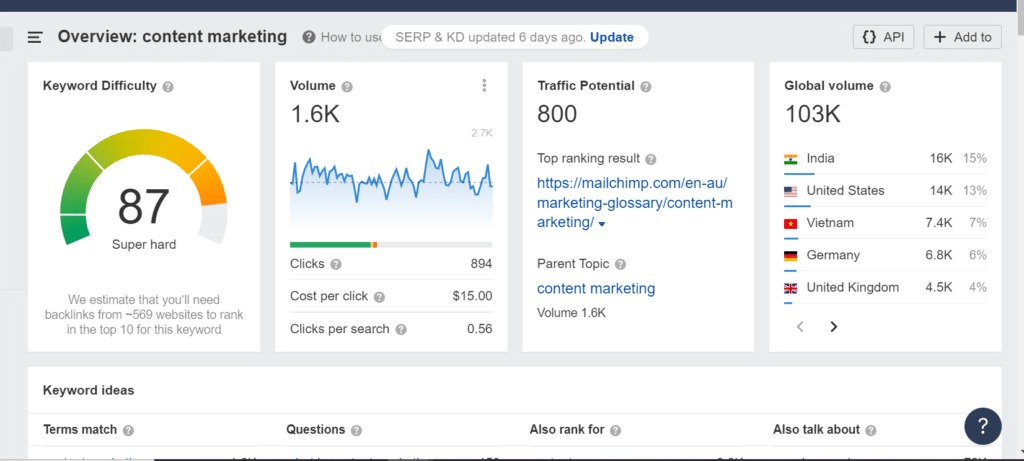
There’s no set rules here but if your domain authority is similar to the keyword difficulty and the ranking sites for that keyword, then you have a good chance.
Especially so if there is a site or business similar to you (a true competitor not just a search competitor) who ranks on the first page with a similar or lower DA.
Moz and Ahrefs both have browser extensions to allow you to analyse the SERP results for DA and other metrics directly from the search.

How to carry out effective keyword research for content topics
Start by entering a broad topic area, then look through the keyword report.
The quick way:
Scan through the list and note keywords that are relevant, have search volume, a low to reasonable keyword difficulty and if possible, some level of CPC and advertiser competition (but don’t let that prevent you from choosing a keyword).
Many tools like SEMrush and Ahrefs have filters to help you refine the list for assessment to make this easier.
The Keywords Everywhere browser extension is also useful for showing you lots of long tail keywords and related keywords that might be good to target.
Generally speaking, low search volume and longer tail keywords have a lower keyword difficulty.
If your site has a very low DA, then you probably want to focus on low keyword difficulty keywords first to start getting some early wins, generating visibility and traffic while you build site authority.
—
The longer, data driven way:
- Export a list of all the keywords related to the topic pillar
- Refine the list for relevance
- Include columns for search volume, keyword difficulty, CPC and competitor density
- Add a column that calculates the difference between your domain authority and keyword difficulty
- Add a column for ranking the keywords based on perceived relevance to a potential customer
- It doesn’t matter if the same score is assigned to multiple keywords
- Perhaps use 1-5 where 1 is a high potential match to your target customer and 5 is a low potential match
- Use ChatGPT or a formula to assign ranking scores to the relevant other columns based on 1 being highest value
- So the keyword with the highest search volume would be 1 for high value, but if the same keyword has $0 CPC and you have 10 keywords that you are assessing, then it would rank 10 for CPC
- Add an average score column to rank the balance between these metrics and sort the sheet by this column low to high
- You now have a data driven list of keywords to target with content that balances value against difficulty / competition
It’s not perfect or some super accurate metric you should live and die by, and statisticians will highlight all the things wrong with it.
It is, however, a great tool to help you add a level of data-driven decision making to your work.
This can help you prioritise where to focus efforts for the fastest results in terms of search visibility and reaching the right audience who might be interested in your products and services.
Armed with this data, you can refine it to your liking.
You might want to filter out all keywords with a difficulty rating of 50+ for example, if your site’s domain authority is 20.
You might want to add other columns depending on your objectives, such as ‘intent’ to further refine your results.
You might also want to add a column for the cost or time investment – and this could be against the parent topic or keyword level individual topic – based on the type, creativity, depth and promotion you think will be required to bring the content to life.
The below is an example table showing you what this might look like. For the purposes of this example, your site has a Domain Authority (DA) of 40.

In the pulling it all together section, you’ll see how to use these skills and research to create an SEO content strategy to achieve your goals.
#5. Learn how to create content for link acquisition
If you want to compete in search and dominate your topic, you need links.
This is a different approach and a different audience to content marketing aimed at attracting your own target audience.
In order to create a link, the person needs to be creating content themselves.
These people who you want to link to your content, are probably NOT your target audience. They are mainly bloggers and journalists along with other content creators.
Here’s 5 types of content that you can deploy in your SEO content strategy to attract links.
1. Research (original, observed or curated) and data-driven content
- A good story angle and creative but clear data visualisation is usually the differentiator when it comes to getting the interest of the media
—
2. Strong opinionated content, especially if it’s going against the grain on the topic, discussing something taboo or controversial.
- You or your client will need courage and thick skin to follow through on this and be prepared to be challenged to back up your point of view
- You will also have to nominate key opinion leaders to be the face of the content and who journalists might want to speak to, who podcasters and YouTubers might want to interview and who the social media comments might be directed towards
- It can work to generate links as people link to it as it supports their point of view, or they link to it in their content that challenges this view
- More media then might link to it if it starts to whip up a debate
- It can work to generate links as people link to it as it supports their point of view, or they link to it in their content that challenges this view
- In rare cases one type of strong opinion based content is intentional ‘flame bait’. This is a post attacking something or someone, or a post designed to ignite tension or polarisation. Careful as this can backfire at the risk of brand damage and should be used sparingly and with a lot of consideration and thought given to it if you choose to take this angle
—
3. Content with very high utility
- Learnings, strategies, tactics, templates or information that is very useful and/or applicable to achieve a positive outcome or avoid potential loss
- Needs to be somewhat novel, either new approach, new templates, new way of using existing products and tools, something usually complex broken down simply, everything in one place / hard to find (all the information might be found online, but you’ve done the hard work to collate it all for people and packaged it into a single location)
—
4. Embeddable visualisations
- Less effective than it used to be, but still good if you have a great piece of creative data visualisation on a hot topic
- You create the infographic or visualisation and provide the embed code in your post so other content creators can embed it on their site to support their content creation efforts.
- The embed code contains a link back to your site
—
5. Content with high natural distribution
- Crowdsourced
- Influencers and experts contribute to the content and due to being featured, are highly likely to share it with their audience and potentially link to it
- Don’t just list them with their comments. Look for common threads, themes, differences of opinion, different ways of solving the same problem or reaching a goal. Group them into segments so there’s a story angle and not just a randomised list of people’s opinions
- Crowdsourced
- Interviews
- Same as crowdsourced but focused on depth of topic from an individual’s perspective
- Interviews
- Lists / awards / [genuine] ego bait
- Content people wish they could share and reference (link to)
- Status is one of the most powerful human needs and motivators. Tap into this and your content has high distribution potential
- If you create a list of the top X people, businesses, blogs, places, then you should also state the criteria you based it on for added credibility
- You can get quite creative with this by thinking about multiple levels of distribution.
- Instead of just creating a list, think about adding dimensions:
- Locations – country, state, region, city, suburb
- Gender
- Age
- Company size
- Company age
- Industry/category
- Thinking about and adding dimensions does 2 things:
- More likely to get the interest of the media as it creates story angles and opens up local and niche media companies
- Increases natural distribution potential by increasing the audiences it will appeal to and the relevance to different groups
- Instead of just creating a list, think about adding dimensions:
- Lists / awards / [genuine] ego bait
—
Finally it’s worth mentioning the age old guest post as a more engineered way to generate links.
Yes they still work when approached correctly and are a good tactic for expanding your reach, credibility and links.
Choose relevant sites that get decent levels of traffic, not purely based on their domain authority. Ideally traffic that might contain your target audience.
Even better is if the site you are guest posting at, carries some level of credibility in your industry.
You will inherit some of the credibility through guest posting at the site and this builds trust with your target audience, leading to higher conversion rates (over time).
Guest post content ideas could be curating the content on your website with a link back to the bigger piece, or content that supports the content on your site through a spin off or supplemental topic, linking back to the relevant topic on your own site.
—
Pro Tip: Reach out to relevant experts and ask them to contribute to your blog as a guest author.
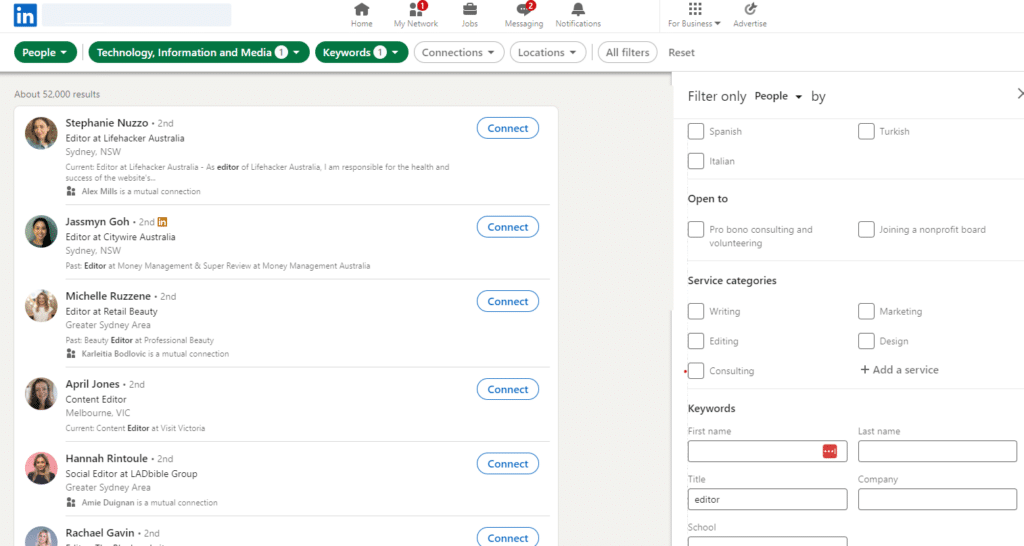
You get free content, they get a link and coverage and you get the benefit and credibility of multiple expert authors associated with your brand. Great signal to the search engines (Experience – Expertise – Authority – Trust) and great credibility and trust in the eyes of your audience.
Use tools such as Sparktoro, Buzzsumo, Followerwonk and LinkedIn to find good people to invite as a guest author, as well as sites that would be good opportunities for you to post at.
In the ‘putting it all together’ section, we show you how to structure an SEO content marketing strategy that incorporates links and digital PR in addition to other content types in order to achieve the objective.
Two points to remember:
- The more people want the information and the harder the information is to find, the more likely your content will perform well.
- Recency matters, to the search engines and to humans. Both want the most up to date information
- That’s why it’s important to audit your content at least once a year
#4. Use content templates to improve productivity, consistency and quality
You have your topic and subtopic pillars and an editorial calendar filled with individual content topics to write about.
You could just start writing about each and every content topic from a blank page every time, making it up as you go… or you could use proven templates to help with structure, focus, productivity and consistency.
Here we go, the creatives will preach about quality and creative freedom and not being confined to a template blah blah…
OK there might be some truth there for senior, experienced creatives trying to craft a masterpiece.
But you’re a marketing professional or entrepreneur.
You need a scalable system that isn’t based on any individual person (people come and go as you know).
A system that consistently achieves the result and delivers the outcome, efficiently, with a level of predictability and enables multiple people with different capabilities and experience levels (above a certain point) to work it effectively.
Having your team use content templates helps with this. A lot.
In terms of actions:
- Here’s a good list of different ‘types’ or angles of content pieces you might want to create
- Review this list and choose the ones you think are relevant and would be a good fit for your own brand and SEO content strategy
- Add any additional ones of your own
- Create a structure template for each of these post types / angles on your list
- You can find content templates online, ask your senior and most experienced content producers to put them together or use AI tools such as ChatGPT
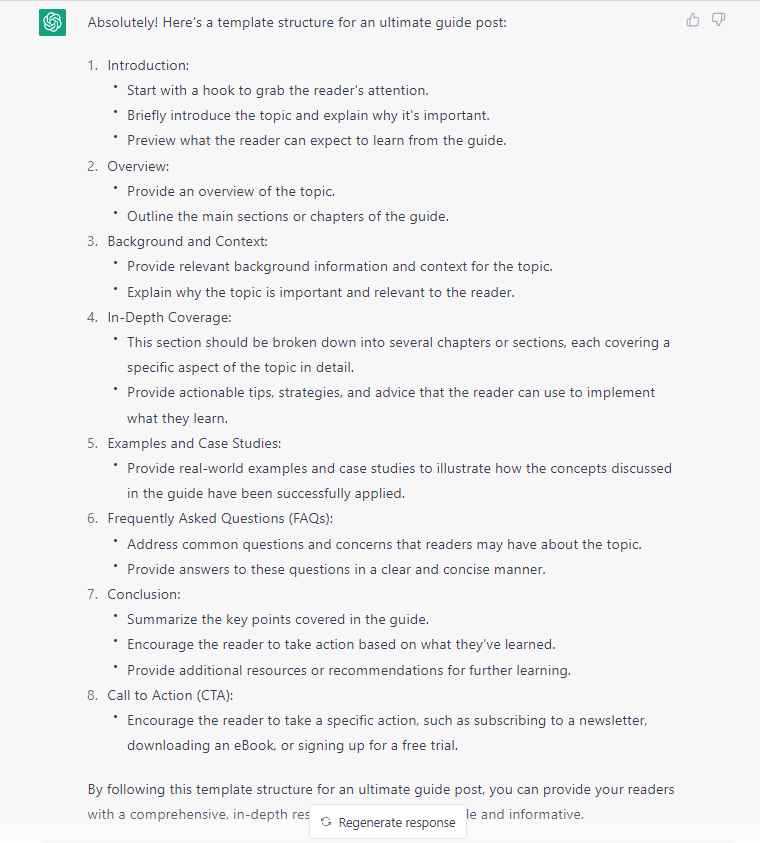
#5. Putting it all together: Creating a clear and effective SEO content strategy
Creating your target cluster or Content Hub.
This part is where a level of experience comes in. There is no cut and dry way to identify EXACTLY what it will take to rank for a keyword or set of keywords.
What we’re about to show you is the methodology to follow.
This methodology has several levers that you can use to improve the search visibility and rankings of target keywords, while building out expertise in the topic pillar.
Those levers are:
- Content quality / depth
- Internal links
- Created by supporting content
- From content to target commercial page
- Digital PR (external links)
- Plus ‘deep linking’
- Usually you don’t just create a single piece of content and hammer it with links.
- Spread the link acquisition throughout the content cluster for more natural, deep linking and higher authority
- Plus ‘deep linking’
- You should also think of the funnel and how you will make offers to move them through the buying journey (but more on that very shortly)
The part that only experience can really teach, is after assessing the competition and keyword difficulty against your own site, knowing approximately how much content you need, in what structure, to what depth and with what level of Digital PR it might take to achieve the goals.
General rule:
If you’re not seeing the results you want, assuming there are no technical issues holding back performance, then you need more content and more links – continue to build on your current structure basically.
Alright let’s break down the methodology of an SEO content marketing strategy.
The hub and spoke structure. This is an example of what you will be building:
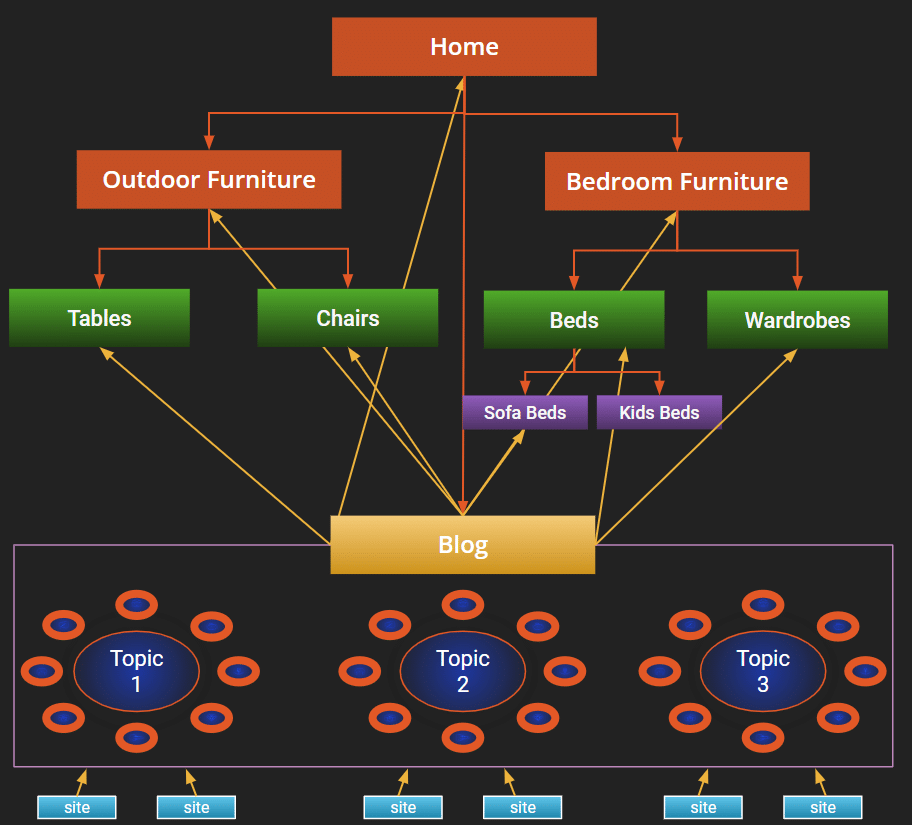
Start by choosing a target. This could be a particular product, service or category or it could be a particular topic or subtopic pillar.
NOTE: The way SEO content marketing improves the rankings of the main commercial pages, is by internally linking to them. This passes the authority generated from the content, back to the commercial pages and improves their rankings. It also builds out the site in the relevant topic, improving expertise and authority overall in this area.
Let’s stick with the home office furniture example used previously in this guide and let’s say your site has a DA of 35.
If we look at the keyword ‘home office furniture’ in Ahrefs, we can see it has low – medium keyword difficulty and decent traffic potential with about 24 referring domains estimated to be required to rank for that keyword… but it’s not as simple as building 24 links and magically ranking for that keyword.

If we look at it in SEMrush, it shows the same, but also that there is high commercial intent, backed up by keywords having cost per click data (CPC) and a high number of advertisers bidding on them (Com. column where 1 is max competition).

There’s also a range of other related keywords in the cluster that also carry good search volume, reasonable competition and high commercial intent.
This matters because the SEO content strategy we’re about to build will benefit the rankings of the entire cluster, if you have pages on your site to match and in the right structure.
So we’ve chosen a commercial keyword group we want to rank for.
Problem is, people don’t tend to naturally link to pages about home office furniture.
You could give products away for reviews and links back to your site as part of the review… but this is against Google’s Webmaster Guidelines and unless the links are marked as no-follow (most of the value taken away), you run the risk of a penalty.
The way we rank for commercial keywords is through excellent SEO content marketing.
If people don’t naturally link to product pages, we need to give them something to link to and pass the power of those links through to the commercial page(s) we want to rank via internal linking.
Look for a tier 1 alignment first before moving out from the brand into bridging topics, one branch at a time.
Remember if the topic was a tier 1 topic like digital marketing, we could create a content strategy around digital marketing, internally linking to our page offering digital marketing services.
Looking at the search questions for the seed keyword ‘home office’, we can see that a lot of people are looking at setting up a home office, seemingly for the first time.
Perhaps they just secured a position that allows them to work remotely or they are setting up their own business from home.
Deeper audience research might provide more insights, but let’s run with this example.
So just browsing the keywords and questions people are asking, we start to see themes develop:
- Setting up a home office
- On a budget
- In a small space
- Finance – tax, expenses etc
- Equipment (tier 1 topic as part of this is your product range in this example)
- Furniture – desks, chairs, accessories
- Computer hardware – monitors, laptops, printers, accessories
- Computer software – MS Office, VPN, ISPs
- Calls and video production
- Design – making it comfortable, cool, hiding things like printers, layouts, colour schemes, plants/greenery, design inspo for different sized spaces and layouts, flooring/rugs/carpets, soundproofing, best for handling a lot of calls, storage
This would make an excellent SEO content strategy. Here’s why:
- Relevant topic
- Lots of subtopics within the parent topic
- Lots of questions and search demand
- Lots of low competition, long tail keywords
- Good potential for hub and spoke structure
- Good potential for Digital PR and generating links and shares
We start by designing a hub and spoke structure that we think will be sufficient to rank for our main commercial keywords, in addition to the topical keywords associated with the hub and spoke topic cluster we will be creating.
So in our home office example, it might look like this:
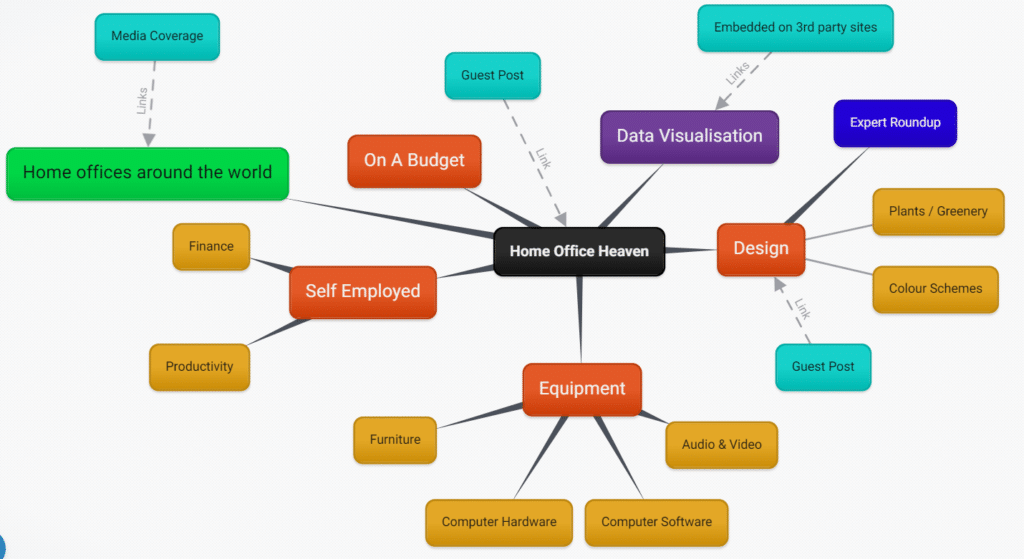
Let’s break it down.
We have our main hero page:
Home Office Heaven: How to set up the home office of your dreams (even in small spaces or on a tight budget)
Or you could lead with the Digital PR angle for the main piece (this would take some deeper research, but for the purposes of this guide, we’ve made up a couple examples off the top of our heads that media might be interested in):
Home Office Heaven: 50 of the most creative and jaw dropping home offices from around the world (grouped by room size)
A possible story angle for the media could be how this differs in different parts of the country or world (e.g. country with the smallest/largest home offices), differences between generations and gender or even industry.
You might also consider a research driven piece analysing work from home trends around the world or across different parts of the country or different industries.
Or if resource and execution potential allows, you could go big and perhaps look at something like Window Swap but for home offices.
—
With the main hero topic and page of the hub set, it’s time to map out the spokes.
There’s 2 main ways to approach this:
- Content Cluster
- Similar structure and methodology, but a scaled down and more focused structure compared to the Content Hub

- Content Hub
- Much more comprehensive resource centre, covering the parent topic and all the child topics extensively

Thinking back to our breakdown of this parent topic – setting up a home office:
- Setting up a home office
- On a budget
- In a small space
- Finance – tax, expenses etc
- Equipment (tier 1 topic as part of this is your product range in this example)
- Furniture – desks, chairs, accessories
- Computer hardware – monitors, laptops, printers, accessories
- Computer software – MS Office, VPN, ISPs
- Calls and video production
- Design – making it comfortable, cool, hiding things like printers, layouts, colour schemes, plants/greenery, design inspo for different sized spaces and layouts, flooring/rugs/carpets, soundproofing, best for handling a lot of calls, storage
With a Content Hub SEO strategy, each of these bullets would be like a category within the master topic of setting up a home office.
Each category would have its own main hero page with a collection of supporting posts within the category… each category would be a Content Cluster all on its own basically.
—
You might choose the Content Hub over a Content Cluster with your SEO content strategy if:
- You have a good level of resource available
- It’s a longer term project (say 6-12 months and beyond)
- It’s a competitive space in search requiring a higher level of content and Digital PR
- You want more visual structure to your website and content marketing strategy
- You think it represents a good commercial opportunity
- You think it would be a great way to attract, grow and engage your target audience
- It’s something the brand wants to be known for and develop expertise and authority through building out a section on the website and online
- Having this asset would benefit other areas of the business
A Content Cluster on the other hand is a more common content marketing approach, suitable for most businesses, quicker to deploy and used by talented digital marketers to improve search visibility, traffic and conversions.
—
In our example, we have our main hero page for the mini hub, so we just need to create spin off pieces of content related to this parent topic (spokes).
The spin off pieces of content are related to the main piece (in line with the bullet list from earlier), meaning internal links between the pages make sense and are relevant.
So for this campaign, taking everything into account, we might decide to create 4 cluster spoke pages, that each have a few spokes of their own:

Next we bring in Digital PR.
We might have 2 guest posts and 1 data visualisation that can be posted onsite and pitched/syndicated offsite.

Let’s try leveraging some distribution and credibility through involving influencers or experts in the topic.
Maybe we add an interview, crowdsourced or targeted list post and/or pitch a company representative for interviews. Maybe we even invite an expert to guest author on our blog.
You can find experts to reach out to using LinkedIn, Buzzsumo, Sparktoro, Followerwonk etc.

Finally let’s run a Digital PR campaign aimed at generating media coverage (if we didn’t choose this for our main hero page).

There is one more thing to add, which is an offer to move a percentage of people through the buying journey. We’ll cover that next in just a moment.
You now have your first draft of your SEO content strategy that’s:
- Strategically targeting high-intent keywords related to your products and services
- Strategically targeting upper funnel keywords to increase visibility and attract your target audience
- A mixture of onsite content and Digital PR for maximum leverage and performance
- Commercial, focused and time bound
Remember:
You will internally link from the pages in the content hub / cluster, to the relevant commercial pages you are targeting and want to improve.
Here’s how your asset plan might break down:
| Asset | Month 1 | Month 2 | Month 3 |
|---|---|---|---|
| Main page | |||
| 4 x cluster pages | |||
| 8 x spoke pages | |||
| 2 x guest posts | |||
| 1 x expert round up | |||
| 1 x media piece |
It’s not just blogging. You are building a solid foundation from which to build and dominate.
As data starts to come in, you assess your results and decide whether you need to up the activity and build things out further.
More content, more internal links, more Digital PR and external links.
Perhaps you turn a spoke into its own cluster… or perhaps what you have designed seems sufficient to achieve the goals.
Great, you win. Now onto the next campaign!
#6. Map the customer buying journey to move people from unaware to new customer to raving fan.
A large percentage of SEO content marketing will focus on the top of the funnel, but you should always consider the customer buying journey when content marketing.
Here’s why (taken straight from our content marketing services page):

So everything starts with great content marketing, but great content marketing also builds an audience.
If you have an audience, you can market to that audience to move them through the buying journey… which is what this section is about and why we are content marketing in the first place… to achieve commercial business objectives.
To do this effectively, you should map your content to the relevant stage in the customer buying journey.
DigitalMarketer.com explain this well in their blog post here.
To do this, create a customer buying journey canvas and for each stage, think of these questions:
- What is the customer trying to do (tasks/jobs)?
- What do they want to achieve or avoid?
- What information are they looking for (or not looking for)?
- What questions might they have?
- What are they researching?
- What is their primary pain point?
- What is their context (their situation at this time)?
- What are their current beliefs?
- What or who might be influencing their thoughts, beliefs and behaviours at this stage?
- What is their current emotional state? What feelings are they experiencing?
- What objections do they have around:
- The category of products and services
- Your products and services
- Your brand
- What existing thoughts, feelings, beliefs and behaviours do we need to change?
Next, map your content to each stage.
Step back and look at where the gaps are, cross referencing with your performance data and objectives.
Pro Tip: Miro.com has lots of ready made canvas templates for you to use in their Miroverse gallery.

Source: Miro – Epic Customer Journey
No matter the industry, you always need 3 things to acquire customers:
- Awareness
- Nurturing
- Trust
For example if you are only active at the top of the funnel but have little to no content at the other stages, then this might be a reason for a low conversion rate.
People are being made aware, but the next thing you are asking them to do is buy something.
It’s probably too much too soon and they need more interactions with your brand (through content) to be gradually inched along, nurturing trust and belief, until they are ready to take that step.
You would therefore adjust your SEO content strategy to include more content aimed at people in the consideration and conversion stages.
A customer buying journey content strategy will certainly improve performance, but don’t leave it to them to figure out the next step to take.
Every piece of content should be allocated to a stage in the buying journey.
And every piece of content should have an appropriate offer.
Some example offers could be to..
- Visit another page on the site, perhaps a commercial product or service page, or a pre-sell page to build intent and belief. An example could be a case study.
- Opt in to a gated content lead magnet in exchange for their email address
- Opt in to claim a coupon, discount code, free trial or special offer
- Book a short call with a relevant person at your company to discuss their problem and your solution (e.g a demo and walkthrough of your product)
- Reserve a seat at your upcoming webinar or event
- Take a quiz or enter a contest
- Leave a review or testimonial
- Refer a friend
- Buy a similar product
- Upgrade their existing product or service
- Renew or extend their subscription
- Remind them to use the product or service or use it in a new way
When brainstorming offers, think of the stage of the customer buying journey, your goal(s) for that stage and what the next logical step is for the person to take to achieve the goal.
#7. Checklist & Conclusion
By now you should have a lot to be getting on with and armed with the right foundational knowledge from which to build a highly effective SEO content marketing strategy.
Here’s a quick recap checklist:
- Audience insights, goals, positioning and content strategy mission
- Topic Pillars
- List of content ideas
- Keyword research
- Digital PR link bait content ideas
- Content templates
- List of guest post targets
- SEO content strategy plan
- Asset list and timeline
- Customer journey map & offers
We hope you got value from this SEO content marketing guide.
Now we’d like to hear from you: Which part of the strategy do you feel you need the most help with?
How does this compare to what you’ve done in the past or are currently doing?
Feel free to get in touch and let us know if you have any questions or need any help with anything.




